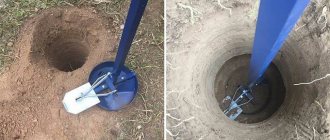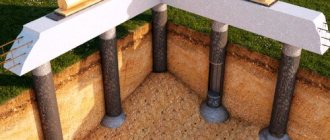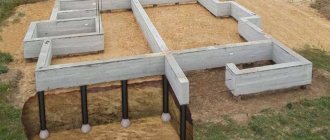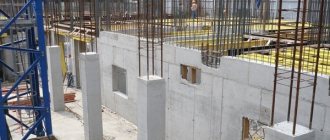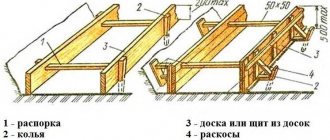TISE formwork allows you to do all the work yourself.
TISE block-based adjustable formwork is a common solution for building walls and foundations. Its difference is the ability to fill formwork blocks with rigid concrete mortar, which is made with minimal addition of water. After filling the block, the concrete is compacted and the formwork is dismantled. This allows you to quickly create a structural element; usually these procedures take no more than 5 minutes. This article will examine in more detail the types and characteristics of TISE formworks.
TISE piles
The main disadvantage of the classic pile foundation is that with severe heaving, the support can simply be pushed out. But since the idea itself is very attractive - it can be built quickly with a minimum of costs - on difficult soils they began to make a base at the bottom of the pile - a rectangular reinforced plate. But with this option, the volume of land work immediately increased significantly: for each pile it is necessary to dig a pit larger than the planned base. But the building stands normally even on soils with severe frost heaving.
The pile foundation using TISE technology has a dome-shaped thickening at the base of each support
Under piles made using TISE technology create a similar thickening. But there is no need to dig pits. This extension is formed using a special knife, which is attached to a proprietary drill. This knife forms the extended dome. Further, the entire technology almost exactly repeats the process of constructing a pile or pile-grillage foundation.
Previously, expansions were also practiced, but they tried to do them using micro-explosions or by picking with a blade on a long pole. The main innovation in TISE technology is a drill with an opening adjustable blade. With its help, it is much easier to expand the sole.
How to work with a TISE drill
Advantages and disadvantages
TISE foundations are quickly gaining popularity: with minimal additional costs, a more reliable foundation is obtained. So, its advantages:
- increased resistance to heaving forces;
- the load from the house is transferred to a larger area, which reduces the possibility of uneven subsidence;
- low cost with good characteristics;
- can be designed for houses made of different materials, up to 3 floors in height;
- small amount of land work.
The procedure for making a TISE pile
If a pile or pile-grillage foundation is recommended for your house, it makes sense to make TISE piles. With a small increase in workload, you get a significant increase in reliability. After all, designers do not like pile foundations because it is impossible to find out what kind of soil is under each support. Therefore, it is impossible to predict how reliable and stable the foundation will be. And the TISE foundation has a wider support, which reduces risks. As before, nothing can be predicted, but a large load distribution area is always good.
However, there are also disadvantages. The main thing: the heel of a TISE pile cannot be well reinforced. You can lower the reinforcement cage to the very bottom, but expansion cannot be reinforced. Therefore, there remains the possibility that this thickening will collapse.
TISE piles are the basis of the TISE pile-grillage foundation
There is one more drawback, but this is from the practice of using a drill: it is not easy for them to work. The design itself is interesting. This is not a blade wrapped around a rod, but some kind of container with a composite bottom. Four blades set at an angle are welded on the plates that form the bottom. When you spin the drill, they loosen the soil. Since the bottom is not solid, the soil gets into the body, from where it needs to be removed.
The order of work is as follows: rotate the drill several times around its axis, take it out, and shake out the soil. They lowered it into the hole again, turned it several times, etc. The technology is not complicated, but the work is tedious. The device itself weighs 7-9 kg, plus soil. It needs to be raised and lowered frequently. Overall, it's tiring. Plus, no mechanisms are needed. The downside is that the work is not easy physically. Especially if the soil is rocky or dense clay.
Advantages and disadvantages of technology
The developers of the TISE adjustable formwork created it specifically for private developers. The technology is designed to reduce the cost and simplify the construction process.
Advice! The unusual name of the equipment is just an abbreviation that stands for “individual construction technology and ecology.”
- reduction of financial and time costs for construction;
- the kit allows you to form concrete blocks with insulation, which after moving into the house will allow you to significantly save on heating;
- the ability to produce building blocks of different thicknesses, which allows you to choose a set that will allow you to carry out construction work as quickly and easily as possible;
- complete fire safety of erected structures;
- the ability to take breaks from work without losing the quality of the structure being built;
- maximum simplicity of work, almost any home craftsman can handle them;
- high speed of construction, the formation of one block takes little time.
The disadvantages include the fact that the structure is not completely monolithic, but consists of separate blocks.
Where can I use it?
There are no restrictions on the types and materials of buildings: you can make a TISE foundation for wooden, frame, brick and block buildings. Number of storeys - up to three.
The restrictions on soils are the same as when using pile foundations: it is necessary that the piles transfer the load to the soil with normal bearing capacity. To decide whether it is possible or not to use TISE, a geological study of the site in the place where construction is planned is necessary.
What does a TISE pile consist of?
Since the base of the pile is expanded and the resistance to buoyancy forces is greater, this technology can be used on heaving soils. But at the same time you need to consider: there is no point in placing piles closer than 1.5 meters. If placed closer, one extension of the sole will overlap the other. On the other hand, you can’t make a pile larger than 30 cm in diameter either - there is no such drill. If the load-bearing area with such parameters is not enough, you need to use a different type of foundation.
Peculiarities
It is not for nothing that the TISE foundation is called universal; it is intended for various soils, the only exception being rocks.
The building may have several floors and a reinforced concrete floor, but this will not affect the strength and reliability of the structure. But this does not mean that it has absolutely no shortcomings. This design has proven itself to be excellent on highly heaving soils, on which other types of foundations crack after a few years. The TISE foundation is appropriate to use in areas located close to railway tracks or a truck highway. An ordinary columnar foundation collapses due to vibrations, but for the TISE foundation they are completely invisible.
The calculation of the foundation must begin with a thorough study and analysis of the site. After this, the territory is marked and drilled. For this, a manual foundation drill TISE F300, F250, F200 is used - the diameter corresponds to the indicator in the name. Piles can be deepened to a maximum depth of 2.20 meters. There are practically no reviews against the TISE foundation; all owners were satisfied with their choice.
Reviews of the branded drill
The main questions for developers are related to how realistic it is to drill wells manually using a proprietary drill. Looking at the video, it seems that this task is not easy. But here are some reviews.
The soil on my site is different: some are loam, some are dense clay, and such that you can only chop them with an axe. At first I thought about renting a motor drill, but I decided to try it straight away with a drill. And nothing, not very hard. As a result, I decided that a motor drill would not speed up the process much, so I made all 40 pieces by hand. During the day, 5-6 2-meter wells were produced. They drilled easily, but with expansion it was difficult: I already had dense soil there, and it was difficult to turn with the blade open.
Oleg, Kharkov
I modified the TISE drill I bought: I welded additional teeth, instead of a rope that opens the blade, I adapted a rod - now you can put pressure on it, and not just pull. And most importantly, I lengthened the handle so that two people could turn it. While they were drilling the extensions, they twisted it 90°, but the work became much easier. In general, I'm pleased.
Nikolay, Krasnoyarsk
Calculation of the TISE foundation
The calculation method is no different from the calculation in the general case. The load from the house is calculated and then compared with the total load-bearing capacity of the planned number and diameter of piles.
First, place the piles on the house plan. They must be in the corners and at the junctions of the walls. If the distance between the piles is more than 3 meters, intermediate ones are placed between them. So you place all the supports on the plan, adhering to the rule:
- minimum distance - 1.5 meters;
- maximum 3 m.
Then calculate the load from the house. To do this, you first need to calculate the weight of the house (all building materials + furniture, plumbing, heavy household appliances).
Average loads from different types of house components
Speaking on average, for buildings made of brick or shell rock, 2400 kg can be taken for each square of area, for light building blocks (foam concrete, aerated concrete, etc.) - 2000 kg, for wood and frames - 1800 kg. These average standards can be used as a preliminary guide. If you decide to take everything seriously, you will need to follow the entire methodology: counting materials of walls, ceilings, roofing, finishing, etc. Since the technologies and materials used may be different, the discrepancies can also be significant.
We multiply the resulting value by a correction factor - 1.3 or 1.4. This is a safety margin. The resulting figure is the load that will need to be transferred through the piles.
Now, using the table, you select what diameter the pile should have so that it can transfer the required weight.
Load-bearing capacity of piles of different diameters in different soils
If the planned number of columns with an expansion of the selected diameter can transfer the required load, you do not need to redo anything. If the transferred mass is too small, it is necessary to either increase the number of piles or make a “heel” of a larger diameter.
Design
TISE technology is a columnar grillage with a widened base of the vertical posts. All columnar foundations have the following disadvantages:
- they are unsuitable for wet soil (high ground level, swamp), fresh embankments and slopes with a height difference of more than 1.5 m between opposite walls of the building;
- making a full-fledged underground or basement floor on pillars is impossible;
- floors on the ground, considered the most economical option, can only be made with a low grillage, which reduces the service life of wall materials, unlike a hanging grillage;
- when using floors in the form of PC slabs or on beams, heat loss increases and insulation consumption increases;
- underground communications should be additionally insulated;
- For any grillage, a backing is required, which increases the construction cost, since the beams are prohibited from resting on the ground.
Technical solution for TISE piles on a steep slope.
The creator of the technology, Yakovlev, considered the lack of special equipment and the minimum possible construction budget to be the main advantages, without specifying what the TISE foundation was compared with. The main advantage is the widening of the base of the pillars, which dramatically increases their load-bearing capacity. It was for the design of the TISE drill, which allows increasing the diameter of the well at the bottom to 60 cm without the use of special equipment, that the author received a patent.
TISE drill.
Conventional hand tools and motor drill equipment allow you to drill holes with a maximum diameter of 50 cm. To make a widening of a standard post using classical technology, you will have to either dig a larger hole or use a hole drill to drill a hole of the appropriate diameter.
In any of these options, you will have to cast a slab at the face, then install smaller formwork, and fill the gaps after the concrete has hardened. The bearing capacity of the column will increase due to the wide heel, but will decrease due to a decrease in lateral friction with the layers adjacent to the body of the column.
For example, when TISE is supported on clay, each vertical post has a load-bearing capacity of 10 - 12 tons. This is three times more than that of pillars without widening or screw/bored piles.
Table: Load-bearing capacity of TISE piles.
The TISE foundation is inferior to other technologies in the following positions:
- a floating slab allows you to build a cottage on wet soil;
- MZLF tape is suitable for projects with a basement;
- bored and screw piles lie not just “below the freezing mark”, but reach the bearing layer, that is, much more reliable than TISE;
- screw piles are the only technology that allows walls to be erected the very next day, since the concrete inside their cavities is not structural, but serves only to protect the internal walls from corrosion;
Cellar inside the TISE foundation.
Due to the high cost of geological surveys, they are replaced by trial screwing in a screw pile in 3 to 5 places inside the building area. The technique allows you to save money (it will cost 1.5 - 2 thousand rubles instead of 30 thousand).
TISE foundation: work order
The TISE technique itself has some recommendations:
- The piles should be buried approximately 20 cm below the freezing level for the region.
- To reinforce the pile, four rods of ribbed reinforcement with a diameter of 10-12 mm are used. The rods should be placed no closer than 4 cm from the edge.
- If the slope of the site is more than 10%, the release of the reinforcement must be connected to the grillage.
- Use either a high grillage - raised 150 mm above the ground, or make a pile-strip foundation with a shallowly buried strip. The second option is used for heavy buildings, the weight of which cannot be transferred through piles; then a tape is made that increases the transfer area.
Scheme of reinforcement of a pile-grillage foundation with a reinforced concrete grillage (pile-strip) - You should not make sand bedding at the bottom of the well: it will not have normal density and will not work.
- To ensure reliable support, use concrete vibrators. Manual vibration using a rebar is ineffective. If your farm does not have such a device, rent it while the foundation is being poured: the strength increases significantly.
- The formwork for the pile is made from roofing felt, roofing felt or glassine rolled into a tube. It is better that it has several layers (2-3). There is no need to fasten them with anything: they twisted them slightly smaller than the diameter and inserted them. The height of this formwork is 15 cm above the ground level, regardless of whether there is a slope on the site or not. It is advisable to sprinkle this protruding piece with sand or soil and compact it around it. This will prevent the roofing paper from falling apart when pouring concrete.
TISE foundation is a subtype of pile-grillage foundation. And the technology for its production is no different. The whole difference is in the drilling process. No others. The work procedure and technology for manufacturing a pile-rosvet foundation are described here. And in this article we’ll better give some practical advice.
Difficulties during drilling
If the soil is very loose - fine sand - the walls of the well may crumble. To prevent this from happening, add water. The sand will compact and hold its shape. Water will also help if the soil is very dry and dense. After drilling a few tens of centimeters, fill the well with water. It will soften the soil, it can be chopped with a shovel or other device, and then removed with a drill.
Drilling wells for the TISE foundation with your own hands is not easy, but it is possible even alone
Difficulties are created by the powerful roots of trees and bushes. They need to be chopped. To do this, the ax handle is welded (attached) to the handle. By sharply lowering it into the hole, the roots are crushed.
How to create an extension
After reaching the design depth of the well, a plow is attached to the drill. It can be fixed in two positions: to form a heel of 50 or 60 cm. The plow is tied to a rope.
This is a plow that forms a dome-shaped extension
You lower the drill down, the rope is taut, the plow is pressed. The rope is released, and he falls down under his own weight. You start to rotate (it’s hard - the cutting surface is large), the blade cuts the soil, forming a thickening.
You can rotate both clockwise and counterclockwise. If clockwise, then try not to press down: there is no need to go deeper. When rotating counterclockwise, only the soil is cut without deepening, but another problem arises: the soil is poured under the drill, pushing it upward.
The optimal order of work is as follows: scroll counterclockwise several times. As soon as you feel that the blade has rested against the arch, make a few turns clockwise, collecting cut soil into the drill body. Take out the drill and pour out the soil. Repeat several times until an extension is formed (the soil stops building up).
On hard soils, working with the plow open can be problematic. Then you can create the expansion in stages. First set the plow to the smallest distance, then increase it to the desired size.
Filling with concrete
If the groundwater level is low, no problems arise: fill it in and treat it with a vibrator. All.
If the groundwater level is high, the heel can be filled immediately after it has been formed. You will only need to insert the reinforcement. Then you knit it before drilling begins. Filling the main part of the well can be left “for later”.
Having placed the reinforcement and formwork, they begin to pour concrete
If there is a lot of water and it comes quickly, you will need a large bag made of thick film with a hole at the bottom. You insert it into the well and pour concrete. Because it is denser, it displaces water. Having filled the heel, pull out the bag. It will be useful for the next piles.
The video below demonstrates the technology of building a foundation with TISE piles and a high grillage.
Installation of formwork
TISE technology is simple, but has its own important nuances. So, the construction of walls begins with the installation of the form. It is installed directly on the foundation block. Other forms are mounted nearby.
The installation of the next row of blocks can begin 4 hours after pouring the previous row (the time is indicated for the warm season; in the cold, it takes longer for the concrete mixture to harden). When creating load-bearing walls, you need to consider the following nuances:
- after laying the concrete layer, the top part must be compacted and polished;
- it is necessary to create recesses in the concrete mixture to ensure better adhesion of the blocks; for this, a transverse metal pin is used;
- if necessary, additional reinforcement can be performed with a metal mesh or reinforcing rods;
- When creating openings for windows and doors, vertical reinforcement is carried out; special sections of partial size are used to form openings.
So, TISE formwork is a special technology that has a lot of advantages. The most significant thing is that even a beginner can do the job. This circumstance is especially appreciated by private developers, since the technology allows construction to begin with minimal financial investment.
